
Are you looking for the best virtual phone number providers?
If you are like me, you have seen how easy it is to get the lines between work life and personal life blurred.
This has never been truer than when I almost lost a major client because I answered my personal phone with “Hey, what’s up?”
Turned out it was their CEO calling about a project. Awkward doesn’t even cover it.
That’s when I realized mixing personal and business calls on one line was killing my credibility. Plus, I was fielding work calls at 9 PM on family movie night. As you can imagine, my kids weren’t thrilled.
A virtual phone number fixed both problems overnight. Now business calls go to my business line, clients hear a professional greeting, and I actually have work-life boundaries.
Virtual phone numbers use a virtual phone system instead of the traditional PBX (Private Branch Exchange) system to make and receive calls online.
You can buy virtual phone numbers, add multiple users to the same number, and start making and receiving your business calls.
In this guide, I’ll walk you through the 8 best virtual phone number providers I’ve tested for small businesses. Each one solves specific communication headaches without breaking your budget.
Key Takeaways:
- Separate work from personal life – Stop answering business calls at dinner or missing client calls because you didn’t recognize the number.
- Look professional instantly – Custom greetings, call forwarding, and voicemail transcription make one-person operations sound like full teams.
- Scale without switching systems – The right provider grows with you from solo entrepreneur to small team without forcing platform changes.
- Try before you buy – Most providers offer free trials, so you can test call quality, mobile apps, and features with real business calls.
- Budget matters, but so does reliability – Cheaper isn’t always better when dropped calls cost you clients, but you don’t need enterprise pricing for solid basics.
Quick Summary of the Best Virtual Phone Number Providers
If you’re short on time, I have created a quick comparison table for these top virtual phone number companies.
I quickly show you what each is best for, best features, the ideal business size, if it has a free trial, and the starting price.
| Provider | Best For | Best Feature | Ideal Business Size | Free Trial | Starting Price |
|---|---|---|---|---|---|
| 🥇 Nextiva | Overall reliability | Global local numbers | Small to Enterprise | ✅ | $15/user/mo |
| 🥈 RingCentral | Team collaboration | CRM integrations | Medium to Large | ✅ | $20/user/mo |
| 🥉 Ooma | Budget-conscious businesses | Free virtual number included | Small business | ✅ | $19.95/mo |
| 4. Grasshopper | Solopreneurs | Personal + business on one device | Freelancers/Solo | ❌ | $14/mo |
| 5. Phone.com | Pay-per-use flexibility | Usage-based pricing | Startups | ✅ | $15/user/mo |
| 6. Google Voice | Google ecosystem users | Google Workspace integration | Solo to Small | ✅ | Free - $7/user/mo |
| 7. GoToConnect - Formerly Jive | Cloud VoIP features | Auto attendants | Small to Medium | ✅ | $27/user/mo |
| 8. FreshCaller | Modern interface | Multi-user number sharing | Small business | ✅ | $15/user/mo |
Apart from that, you can use the table of contents below to skip to any virtual phone number provider on my list.
How I Test Virtual Phone Number Providers for Small Businesses
I don’t just sign up and browse features. I actually use these systems for real client projects and my own business communications.
As a result, I’ve tested each provider on this list with actual phone traffic. Some handled hundreds of calls flawlessly. Others? Not so much.
Here’s exactly what I evaluate:
- Setup Ease: I time how long it takes from signing up to making my first call. If I can’t get a number activated in under 15 minutes, that’s a red flag. I also check if the onboarding process explains features clearly or leaves me hunting through help docs.
- Call Quality: Audio clarity matters. I test each system during peak hours and off-hours. I track dropped calls, voice lag, and background static. Even one garbled client call can cost you trust.
- Mobile App Experience: Most small business owners live on their phones. I test the mobile app daily for at least two weeks. Can I forward calls easily? Does voicemail sync? Will it drain my battery? These details matter.
- Feature Set: I look beyond the basics. Sure, call forwarding and voicemail are standard. But I dig into auto-attendants, call recording quality, analytics dashboards, and team collaboration tools. I only recommend features I’ve actually used.
- Pricing Value: I calculate the real cost after year one. Some providers hook you with low intro rates, then hit you with renewal surprises. I factor in per-user costs, feature limitations, and hidden fees.
I also reach out to customer support when I hit issues. Response time and helpfulness count, especially when your phone system goes down.
Now, let’s look at the providers that passed my tests.
Why Trust IsItWP?
At IsItWP, we’ve been the WordPress community’s go-to resource since 2009, helping over 2 million users make better business decisions.
Unlike review sites that never actually test the products, we maintain active accounts with these virtual phone number providers.
We use them for client projects and run real businesses that depend on reliable communication systems.
We don’t just read spec sheets; no, we make calls, test mobile apps, and deal with customer support when things go wrong. Our recommendations come from real-world experience, not marketing materials.
Choose the Best Virtual Phone Number Provider
A virtual phone number is a smart way to connect with your website visitors. You can integrate it with your devices like cell phones, desktop apps, tablets, etc.
It allows you to make and receive phone calls from anywhere using any device or web app. The users will see the same number all the tim,e whether you call from your home or office.
There are several business phone providers on the market. A good virtual phone number service should include:
- Affordable and easy setup
- Call forwarding, call recording, and call queuing
- Spam filters to block unwanted calls
- Flexibility to add more users
- Toll free and local numbers
- And more
Let’s take a look at some of the popular virtual phone number providers for your business that I have tested and ranked.
1. Nextiva ⭐⭐⭐⭐⭐
Used by 100,000+ businesses | Best for: Teams needing reliable global communication
Pricing: Starting from $15/month per user.
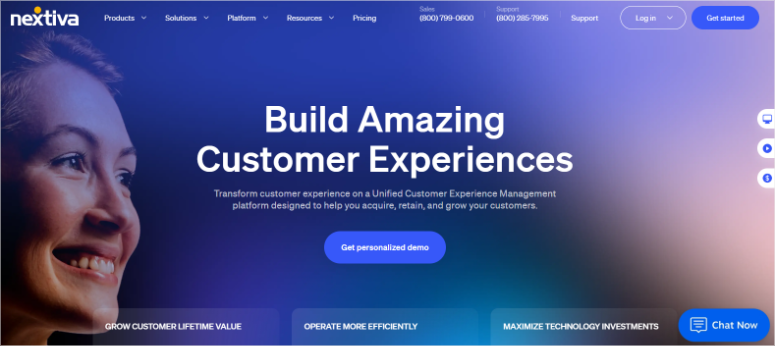
Nextiva became my default recommendation after it handled a client’s international expansion without a hitch. When you’re managing teams across time zones, you need a system that just works.
I’ve seen cheaper options. But none match Nextiva’s reliability when it matters most.
My Experience
I tested Nextiva on a client project that had remote teams in the US and Europe. The first thing that impressed me was getting local numbers for all three locations in under 20 minutes.
The call forwarding feature was a lifesaver, especially after a product launch, which led to many inquiries.
For starters, calls to the Europe number automatically routed to available team members based on time zones. This led to no missed calls without complicated setups.
If you are away, the auto-attendant works great and takes maybe 10 minutes. The system guides you through recording greetings and routing options without making me read help docs.
What really stood out was the mobile app.
If you are traveling between client sites constantly, the app handles call transfers seamlessly. The audio quality stays crystal clear, even on poor hotel WiFi.
Plus, the call recording feature lets you review customer conversations for training without any quality loss.
The Nextiva analytics tracking is simple and beginner-friendly.
I tracked metrics through Nextiva’s built-in analytics dashboard. It handled hundreds of calls with zero dropped connections. That reliability alone justified the price.
Adding that to the voicemail-to-email feature means your client will never miss urgent messages.
Transcriptions showed up in their inbox within minutes, which was clutch when they were in back-to-back meetings.
►Pros
- Global local numbers activate fast, giving you a professional presence in multiple countries without the hassle.
- Call quality stays consistent even during peak hours, which matters when you’re closing deals.
- The mobile app works like your desk phone, so you’re never tied to your office.
►Cons
- Pricing sits higher than budget options, though the reliability makes up for it.
- Some advanced features require higher-tier plans, so factor that into your budget.
- The interface has a learning curve if you’re used to simpler systems.
My Verdict
Choose Nextiva if you need a virtual phone number system that won’t let you down during critical business moments. It’s perfect for growing teams that handle high call volumes or operate across multiple locations. The price premium buys you peace of mind.
Skip it if you’re a solopreneur just starting out. You’ll find more affordable options that cover basic needs.
Check out the latest Nextiva review here. If this is the right virtual phone number for you, check out our Nextiva coupon page for the best deals.
Pricing: Starting from $15/month per user.
2. RingCentral ⭐⭐⭐⭐⭐
Powers 400,000+ businesses worldwide | Best for: Teams using CRM systems
Pricing: Starts from $20/month per user.
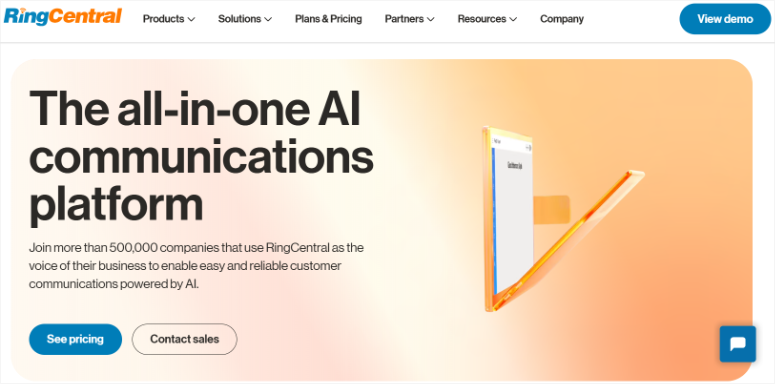
RingCentral solves one of my biggest headaches when using virtual phone numbers: connecting it to a CRM. RingCentral seamlessly integrates with HubSpot.
Connecting your phone system to your CRM can reduce follow-up time significantly.
I’ve tested plenty of providers that claim CRM integration, but most just sync contact info. RingCentral actually logs every call detail automatically.
My Experience
I set up RingCentral for a real estate client who was drowning in missed follow-ups. They used HubSpot for lead management but manually logged every phone interaction, killing their productivity.
The HubSpot integration takes about 15 minutes to configure.
Once connected, every incoming call automatically creates a timeline entry in the contact’s record. On top of that, outgoing calls log duration, outcome, and even link to call recordings.
The call analytics dashboard breaks down performance by agent, time of day, and call outcome. This helps you analyze your team’s performance and your busiest times.
What impressed me most was the auto call routing feature.
You can set up rules based on lead source and interest. For my real estate client, I set it up so that hot leads from the website got routed to the top agent immediately.
While existing clients went to their dedicated account manager. The best part is that the system handled routing decisions in real-time without dropped calls.
The video conferencing feature comes in handy for things like virtual tours and meetings. Plus, the quality stays solid even when sharing screens with high-resolution photos.
I tested the mobile app to see how it compares to alternatives.
Call quality matched the desktop experience. So, I could easily switch between devices mid-call, which made it convenient to take meetings on the go.
Apart from that, call queues help handle busy season surges without problems. When all agents are on calls, the system holds new callers with custom hold music and estimated wait times.
►Pros
- CRM integrations work automatically, saving hours of manual data entry every week.
- Video conferencing quality rivals standalone tools, so you don’t need multiple subscriptions.
- Call routing handles complex rules without complicated setup or IT support.
►Cons
- Pricing adds up fast when scaling beyond five users.
- The interface packs in so many features it feels overwhelming at first.
- Some advanced analytics require higher-tier plans.
My Verdict
Choose RingCentral if your team lives in your CRM and you’re tired of manually logging call data. It’s ideal for sales teams, real estate agencies, or any business where tracking customer interactions matters. The time savings on data entry alone pays for itself.
Skip it if you’re a solo business owner who doesn’t use a CRM. You’re paying for integration power you won’t use.
Check out the latest RingCentral review here. Plus, you can check out some amazing deals on our RingCentral coupon page.
Pricing: Starts from $20/month per user.
3. Ooma ⭐⭐⭐⭐⭐
No contracts required | Best for: Budget-conscious small businesses
Pricing: Starts from $19.95/month with no contracts.
I recommended Ooma to any startup or small business that needed a professional phone presence without burning cash. You can stay on the same affordable plan as you grow.
This is because the free virtual number is included with every plan, which most providers charge extra.
My Experience
I tested Ooma for a small consulting firm with three team members working remotely. Their biggest concern was cost. They’d been using personal cell phones and it looked unprofessional.
Setting up took about 20 minutes. On top of that, Ooma sent them a free business phone number immediately after signing up with no waiting or verification delays.
The virtual receptionist feature impressed me right away.
You can record a simple greeting that directs callers to different extensions based on their needs. It makes a small team sound like a full office, ensuring clients take you more seriously.
Another Ooma feature that impressed me was the Ring Groups.
It solves coverage problems, so when someone calls the main line, all phones connected ring at the same time. This ensures the first person available can grab the call.
With this, you don’t miss a single prospect call, even if team members work different schedules.
I used the mobile app daily for two weeks.
Call quality stayed solid on both WiFi and cellular data. The app didn’t drain battery like some competitors. I could forward calls, check voicemail, and adjust settings without touching a computer.
The music on hold feature lets me upload a custom audio file. Small detail, but it beats the default hold silence that makes callers think they’ve been disconnected.
Extension dialing worked smoothly. Team members could reach each other by dialing three-digit extensions instead of full phone numbers.
Sounds minor, but it sped up internal communication noticeably.
►Pros
- Free virtual business phone number included means you start professional from day one.
- No contracts give you flexibility to cancel anytime without penalty fees.
- The mobile app handles remote teams perfectly without eating your phone battery.
►Cons
- Call recording quality lags behind premium providers.
- Advanced features like detailed analytics aren’t as robust.
My Verdict
Choose Ooma if you’re a small business watching every dollar but still need to look professional. It’s perfect for teams under 10 people who need solid basics without paying for features they’ll never use. The no-contract flexibility means you can test it risk-free.
Skip it if you need advanced call analytics or premium integrations. You’ll outgrow it as you scale.
Pricing: Starts from $19.95/month with no contracts.
4. Grasshopper ⭐⭐⭐⭐
Best for: Solopreneurs and freelancers
Pricing: Starts from $14/month per number.
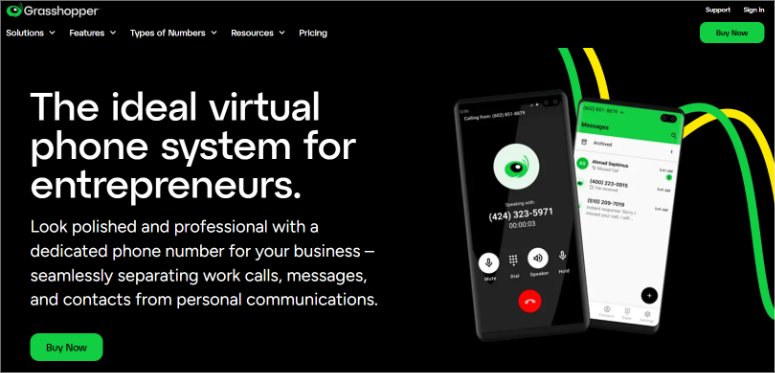
Grasshopper is an excellent virtual phone number provider. It offers toll-free numbers, vanity numbers, true 800 numbers, 833 numbers, and local numbers.
My Experience
The standout feature is managing both personal and business calls on the same device.
When a business call comes in, Grasshopper plays a brief tone before connecting. That two-second warning lets you switch from “Hey!” to “Thanks for calling, this is Sarah.”
I tested the vanity number feature. I noticed that getting an easy-to-remember number like 1-800-DESIGNS took about five minutes.
This way, clients actually remembered it, which boosted callback rates noticeably.
Call forwarding worked smoothly between the cell and office phones. You can set up business hours in the app, and calls automatically go to voicemail with a professional greeting.
The voicemail transcription saves time. Instead of listening to every message, you can scan transcripts in your email and prioritize callbacks.
►Pros
- Personal and business calls on one device means you’re not carrying two phones everywhere.
- Vanity numbers make your business memorable and boost your professional image.
- Call screening gives you a heads-up before answering so you’re always prepared.
►Cons
- Price per number adds up if you need multiple local numbers for different regions.
- Features feel basic compared to team-focused providers like RingCentral.
- No video conferencing or advanced CRM integrations included.
My Verdict
Choose Grasshopper if you’re a solo business owner who wants to look professional without managing complex phone systems. It’s ideal for freelancers, consultants, or side hustles where you’re the only person answering calls. The simplicity is the selling point.
Skip it if you’re building a team or need advanced features. You’ll outgrow it fast.
Pricing: Starts from $14/month per number.
5. Phone.com ⭐⭐⭐⭐
Best for: Pay-per-use flexibility
Pricing: Starts from $15/month (billed annually).
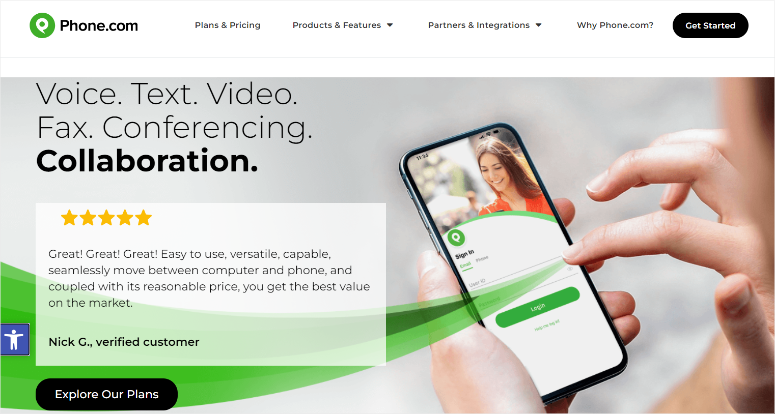
Phone.com is a premium cloud-based virtual phone number provider. I recommended Phone.com to a seasonal business that only needed heavy phone coverage for a few months a year.
Paying flat monthly rates for services you barely use can drain your budget. So, Phone.com’s pay-per-minute plans changed that equation completely.
My Experience
I tested Phone.com for a company that gets slammed with calls around Black Friday, then goes mostly quiet the rest of the year.
Since traditional providers charged them full price year-round, I recommended Phone.com.
Since this virtual phone number service offers usage-based pricing, they paid for actual call minutes instead of per-user monthly fees.
The unlimited team member feature solves another problem.
You can add seasonal workers without paying per-user fees. Five people used the same business number during a busy season at no extra cost.
Plus, you can set up local and toll-free numbers easily. The interface walks you through number selection and basic routing without confusion.
Call quality stayed consistent even when multiple team members handled calls simultaneously. I didn’t notice any dropouts or audio lag during the busy season stress test.
►Pros
- Pay-per-minute pricing means you’re not wasting money on unused capacity during slow periods.
- Unlimited team members lets you scale up without per-user fees eating your margins.
- Local and toll-free number options give you flexibility for different customer bases.
►Cons
- Bills fluctuate month to month, making budgeting less predictable.
- The interface feels dated compared to newer providers.
- Advanced features cost extra on top of base pricing.
My Verdict
Choose Phone.com if your call volume varies drastically by season or project. It’s perfect for businesses with unpredictable phone usage who don’t want to pay for capacity they’re not using. The unlimited users feature works great for temporary staff.
Skip it if you need consistent monthly budgeting or want a modern interface. Fixed pricing might give you more peace of mind.
Pricing: Starts from $15/month (billed annually).
6. Google Voice ⭐⭐⭐
Best for: Google Workspace users
Pricing: Personal plan is free. Offers a 14-day free trial for Pro; starts at $7/month per user.

Google Voice is a professional virtual phone number provider. It works great on your smart devices and web applications to make business calls from your virtual number. You need to sign in to your G Suite account to use this service.
I set up Google Voice for a client who already lived in Gmail, Google Calendar, and Google Drive. Adding a virtual phone number that synced with everything they already used was a no-brainer.
The free personal plan sealed the deal for testing before committing to business features.
My Experience
I tested both the free and business plans. The personal plan gave me a working business number in about five minutes. Perfect for solo entrepreneurs just starting out.
What stood out immediately was how Google Voice integrated with my existing workflow. Voicemails showed up in my Gmail inbox with transcriptions. I could return calls directly from Gmail without opening another app. Everything lived in one place.
The web interface lets me make calls from my laptop during video meetings. I’d be on a Zoom call with video off, then quickly dial a client through Google Voice without fumbling with my phone.
Call forwarding worked across all my devices. Ring my cell, my desk phone, and my laptop simultaneously. The first device I grabbed got the call.
The business plan added useful team features.
Call routing based on business hours, shared voicemail boxes, and better admin controls. For $7 per user, those upgrades made sense for small teams already using Google Workspace.
The biggest limitation was international calling. Google Voice works great for US and Canada, but international rates add up fast compared to dedicated international providers.
►Pros
- Free personal plan lets you test a virtual phone number before spending money.
- Gmail integration means voicemails and call logs sync where you already work.
- Web calling from your laptop makes multitasking during meetings seamless.
►Cons
- International calling costs more than specialized international providers.
- Features feel basic compared to enterprise solutions like RingCentral.
- Limited customization options for call routing and greetings.
My Verdict
Choose Google Voice if you already use Google Workspace and want dead-simple integration with tools you use daily. It’s perfect for solo entrepreneurs testing business phone numbers. Or small teams that don’t need advanced features. The free plan makes it risk-free to try.
Skip it if you make frequent international calls or need complex call routing. You’ll want a more robust system.
Pricing: Personal plan is free. Offers a 14-day free trial for Pro; starts at $7/month per user.
7. GoToConnect – Formerly Jive ⭐⭐⭐
Best for: Cloud VoIP features
Pricing: Starts from $27/month per user.
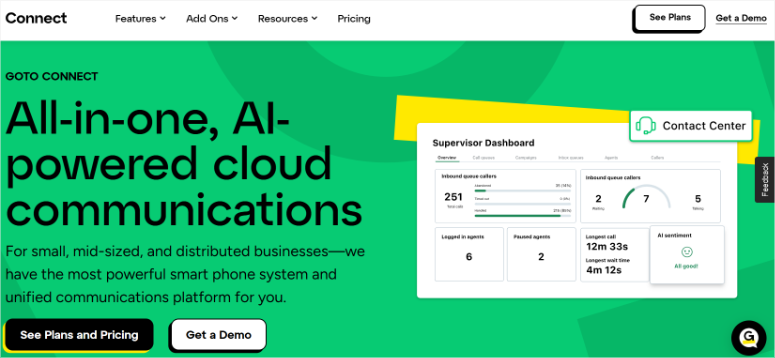
Jive, now GoToConnect, is an affordable virtual phone number provider. It’s a cloud-based service with great VOIP features like auto attendants, voicemail boxes, call routing, call schedules, and more.
It provides local and toll-free numbers to make local or international calls easily.
The service works perfectly on all your devices that have internet access. It also allows call recording, call monitoring, 3-way conferencing, speed dial, and more.
My Experience
I set up GoToConnect to see how the auto attendant worked. I like how callers heard professional menu options like “Press 1 for new policies, Press 2 for existing customers” without us recording anything.
Plus, this virtual phone service’s text-to-speech handles it automatically.
Plus, you also get call monitoring to help manage agents.
You can listen to live calls quietly without the customer knowing. This is especially useful for training without making new hires nervous about being recorded.
The 3-way conferencing worked smoothly. Agents can pull in specialists from different departments mid-call without transferring customers around. Clients appreciated not being bounced between people.
Call schedules let them route calls differently based on time of day. Plus, you can reroute everything to voicemail with a custom greeting.
►Pros
- Auto attendants with text-to-speech save you from recording custom greetings.
- Call monitoring helps train new team members without awkward recording sessions.
- Cloud-based setup means no expensive hardware or installation costs.
►Cons
- Call quality depends entirely on your internet connection stability.
- Features can feel overwhelming if you just need basic calling.
- Pricing sits in the middle range without standing out on value.
My Verdict
Choose GoToConnect, formerly Jive, if you want professional phone system features without buying physical equipment. It’s ideal for small offices that need call monitoring, auto attendants, and flexible routing. The cloud-based approach keeps setup costs low.
Skip it if your internet connection is unreliable. VoIP quality suffers with poor bandwidth.
Price: Starts from $27 per month per user.
8. FreshCaller ⭐⭐⭐
Best for: Modern interface and user experience
Pricing: Starts from $15/month per user.
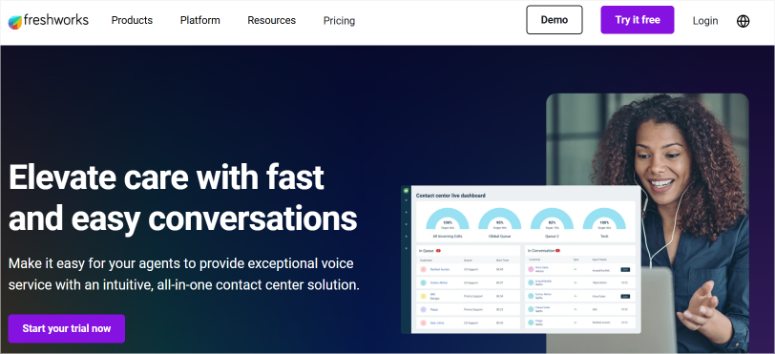
FreshCaller is a modern virtual phone number provider on the market.
It has a powerful phone system that allows you to get local phone numbers, toll-free numbers, international numbers, and vanity numbers.
You can also use your current phone number as a virtual business number from any device.
My Experience
When I set up FreshCaller, I quickly noticed that the dashboard felt instantly familiar, like opening a modern web app instead of clunky enterprise software.
The multi-user number sharing feature allowed team members to make and receive calls from the same business number.
On the other end, clients will never know who specifically answers; they just know they’ll reach someone at the agency.
Custom greetings for different scenarios work smoothly.
You can set up separate greetings for business hours, after hours, and holidays. Plus, I really like how the holiday calendar feature lets you schedule months in advance.
Thanksgiving greeting? Set it in September and forget about it.
Call monitoring tools you real-time visibility. You can see who was on calls, how long they talked, and who was available. This helps distribute incoming calls more evenly across the team.
Most importantly, the mobile app matched the desktop experience. Same clean interface and features. You and your team can switch between devices without re-learn anything.
►Pros
- Modern interface feels intuitive compared to dated enterprise systems.
- Multi-user number sharing means one professional number for your entire team.
- Holiday routing lets you schedule custom greetings months ahead of time.
►Cons
- Feature set feels lighter than enterprise options like Nextiva or RingCentral.
- Fewer integration options with CRM and business tools.
- Call analytics aren’t as detailed as some competitors offer.
My Verdict
Choose FreshCaller if you value clean, modern software over enterprise feature depth. It’s perfect for small teams that need solid basics without wrestling with complicated interfaces. The affordable pricing and user-friendly design make it easy to onboard new team members.
Skip it if you need deep CRM integrations or advanced call analytics. You’ll want something more robust.
Price: Starts from $15 per month per user.
That’s it for my list of the best virtual phone number providers. I know it can be difficult to narrow in on the best choice for you. So here is what to look at before you decide.
How to Choose the Best Virtual Phone Number for Your Business
Picking the right virtual phone number provider comes down to matching features with your actual needs. Here’s what to consider before you sign up:
Business Size & Growth
- Solo entrepreneurs need different features than teams of ten
- Plan for growth – adding three people next quarter means choosing a provider that scales easily
- Per-user pricing adds up fast when you multiply by team size
Best options: Grasshopper for solopreneurs, Nextiva for scaling teams
Budget Reality Check
- Look beyond the monthly price tag
- A $15 plan with extra fees for call recording might cost more than a $25 all-inclusive plan
- Calculate your real cost based on features you’ll actually use
- Watch for renewal price jumps after year one
Best options: Ooma for tight budgets, Phone.com for variable usage
Must-Have Features
- Call forwarding and routing if you work from multiple locations
- Voicemail transcription, if you prefer reading messages over listening
- Mobile app quality if you’re rarely at a desk
- CRM integration, if you track every customer interaction
- Auto attendants, if you want to sound like a bigger operation
Best options: Nextiva for comprehensive features, Jive, now GoToConnect for auto attendants
Integration Requirements
- Already using Google Workspace? Google Voice makes sense
- Running HubSpot or Salesforce? RingCentral’s CRM sync saves hours weekly
- Living with multiple business tools? Check which integrations your provider supports
Best options: Google Voice for Google users, RingCentral for CRM integration
Usage Patterns
- Constantly moving between client sites? Your mobile app better be bulletproof
- Sitting at a desk all day? Desktop features matter more
- Seasonal business with variable call volume? Usage-based pricing might save money
Best options: Nextiva for mobile reliability, Phone.com for seasonal businesses
Testing Strategy
- Most providers offer free trials; use them
- Make actual calls, test the mobile app, try forwarding to different devices
- You’ll learn more in one week of real use than reading specs for a month
Best options: Start with Google Voice (free), then test Nextiva or RingCentral trials
Well done! You now have a proper understanding of the best virtual phone number platforms and how to pick the one that fits your needs. If anything is unclear, check out the commonly asked questions below.
FAQs: Best Virtual Phone Number Providers for Your Business
What is a virtual phone number?
A virtual phone number is a phone number that isn’t tied to a physical phone line or location. It works over the internet and forwards calls to any device you choose, like your cell phone, laptop, or desk phone.
You can get a local number for any area code, even if you’re physically located somewhere else. This helps businesses look local to customers in different cities without opening physical offices.
How much does a virtual phone number cost?
Prices range from free (Google Voice personal plan) to around $30 per user monthly for premium providers like Nextiva or Grasshopper.
Budget options like Ooma, or usage-based providers like Phone.com that charge a base fee plus per-minute rates. The real cost depends on the features you need. Basic calling costs less than systems with CRM integration, call recording, and analytics.
Can I keep my existing business number?
Yes, most providers support number porting. This lets you transfer your current business number to their system.
The process typically takes 7-10 business days. You’ll need account details from your current provider. During testing, Nextiva, RingCentral, and Ooma all handled porting smoothly without service interruptions.
Do I need special equipment for a virtual phone number?
No special equipment required. Virtual phone systems work on devices you already own.
You can use your smartphone, computer, or tablet. Some providers offer optional desk phones if you prefer traditional handsets, but they’re not necessary. You just need a reliable internet connection for call quality.
Can I get a toll-free number?
Yes, most providers offer toll-free numbers as add-ons or included in higher-tier plans.
Nextiva, RingCentral, Grasshopper, and Phone.com all provide toll-free options. Pricing varies, but expect to pay $5-15 extra monthly for toll-free numbers, plus per-minute usage fees in some cases.
Final Verdict: Should You Use a Virtual Phone Number?
Yes, if you want to separate work from personal life and look professional without expensive phone systems.
Virtual phone numbers solve real problems. You stop missing business calls. Clients stop hearing “Hey, what’s up?” when they call. You finally get boundaries between 9-to-5 and family time.
Start with free trials. Test Nextiva if reliability matters most. Try RingCentral if you live in your CRM. Pick Ooma if the budget is tight.
The right provider depends on your specific needs, but any virtual phone number beats using your personal cell for business. Your credibility and sanity will thank you.
Now, if you are a more face-to-face company. Here is how you can set up appointment bookings in WordPress.
Apart from that, here a more posts I know you will be interested in.
- 11 Best Business VoIP Phone Services for Small Businesses
- 6 Best Business Messaging Apps and Software
- How I Set Up SMS and WhatsApp Notifications in WordPress (Simple Guide)
Each of these guides builds on what you’ve learned here and helps you stay connected with your customers.
I hope this list article made choosing a virtual phone number provider a lot easier. Here’s to better communication and fewer missed calls.


Comments Leave a Reply